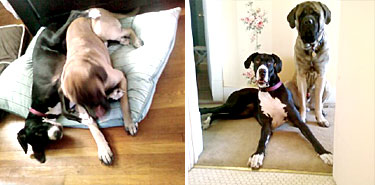Decreasing the Risk of Gastric Dilatation and Volvulus
Everyone with a large, deep-chested dog knows what a scary and serious condition GDV – gastric dilatation and volvulus - is. GDV is a medical emergency in which the stomach dilates and twists on itself, causing damage to the entire cardiovascular system, the stomach, and sometimes the spleen.

Riley and James - high risk due to their breeds, but no occurences of GDV thank goodness!
Gastric – of the stomach
Dilatation – expansion
Volvulus – twisting
Dogs with GDV often attempt to vomit but cannot and have a visibly bloated stomach, which is why GDV is commonly known as bloat.
Time is of the essence in treating GDV. Gastric dilatation and volvulus, even with surgical correction, can be fatal. When possible, prevention is always ideal!
Large and Giant Breed Dogs are at the Highest Risk of GDV
All dogs, cats, guinea pigs and rabbits are at some risk for GDV, but the pets at the highest risk are large and giant breed, deep-chested dogs.
Decreasing the Risk of Gastric Dilatation and Volvulus - Gastropexy
If a pet has his or her stomach surgically attached to the inside of their body wall, the stomach will be able to dilate, but not twist – the most dangerous part of the condition. This surgical procedure is called a gastropexy.
Gastr/o – relating to the stomach
Pex/y – to attach
We recommend that all giant breed dogs have a gastropexy done as puppies. If they are going to be spayed or neutered, we can do both procedures in one visit.
At Gentle Doctor Animal Hospitals, we do gastropexy surgeries laproscopically which involves two very small incisions and a much shorter healing time than with traditional surgery!
Our combined goal as a veterinary community and large breed dog lovers over the past several years has been to do all we can to prevent this condition from occurring. The difficult part of that goal is that we only know in part what causes gastric dilatation and volvulus.
Minimizing the Risk of Gastric Dilatation and Volvulus
Here are the known risk factors for gastric dilatation and volvulus from veterinary surgical specialist, Dr. Eric Monnet1:
-
Feeding only once a day increases the risk of GDV. We recommend at least two meals a day for every dog.
-
A “fast eating style” increases the risk of GDV. Ask us about “Brake-Fast” bowls that can help your dog slow down at meal times!
-
Exercise or stress after a meal increases the risk of GDV. We recommend one hour of “down time” after meals for large and giant breed dogs.
1Monnet, E. 2012. Gastric Dilatation-Volvulus: Controlling the Crisis. Veterinary Medicine. October 1, 2012.
What Suggestions Do You Have for Other Pet Lovers to Decrease the Risk of GDV?
What have you done for your big dogs to decrease the risk of GDV? Has your pet had gastropexy surgery? What has been your experience with gastric dilatation volvulus? Call us or add to the comments here with questions about GDV, preventing GDV and the gastropexy surgery.
